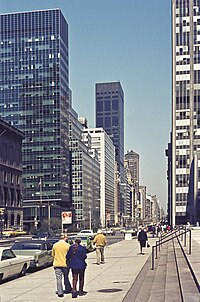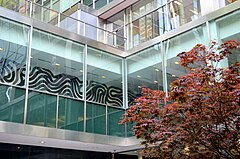Lever House
The building was nearly demolished in the 1980s, when Fisher Brothers proposed a 40-story tower on the site; afterward, it was narrowly approved as a New York City designated landmark in 1982 and was added to the National Register of Historic Places the next year.
[12] Twenty of these were demolished in 1936 and replaced by the Art Deco Normandie Theater, as well as a one-story "taxpayer" building that was intended to preserve the site for future development.
[25][26] The ground level of Lever House consists predominantly of an outdoor plaza, paved in light- and dark-colored terrazzo, with some indoor sections.
[27] The columns, which extend to the underlying rock, are set 10 feet (3.0 m) behind the lot boundary to avoid interfering with the walls of the Park Avenue railroad tunnel.
[39] This design also served a technical purpose, as it complied with the 1916 Zoning Resolution, intended to prevent new skyscrapers in New York City from overwhelming the streets with their sheer bulk.
[3][35] As a result of the slab's small size, Lever House has a floor area ratio (FAR) of 6:1, compared to a FAR of 12:1 at Rockefeller Center and a FAR of 25:1 at the Empire State Building.
[30] A provision under the 1916 Zoning Resolution had allowed structures to rise without setbacks above a given level if all subsequent stories covered no more than 25 percent of the land lot.
[37][54][58] Lever Brothers wanted the building to be "a symbol of everlasting cleanliness",[57] and, according to Curbed, the scaffold was used for a publicity stunt that "used Lever-brand Surf soap to scrub the windows clean".
[63] Lever House's wind bracing system consists of transverse bents placed at intervals of 28 feet (8.5 m), with one set of columns through the interior of the slab.
[23][67][68] A Lever spokesperson said the design choice was an intentional architectural and public-relations feature, saying, "The fact is shops don't rent for much on Park Avenue.
Day,[74] The Hulks by Jeff Koons,[75][76] The Snow Queen by Rachel Feinstein,[77][78] Robert Towne by Sarah Morris,[79][80] and several sculptures by Keith Haring[81] and Tom Sachs.
[10][84] As of 2023[update], the restaurant space is occupied by Casa Lever, whose design includes alcoves with black leather upholstery, black-and-white terrazzo floors, and banquette booths with wood frames.
[85] The second and largest floor contained fan, stock, mail, and stenography rooms, in addition to the employees' lounge and medical suite.
[64][91] Lever Club is decorated with green marble walls and floors;[91] the space includes conference rooms, lounge seats, and a bar and restaurant.
[102][103][104] The company's president, Charles Luckman, announced the executive offices would be moved from Cambridge to New York City that December, taking temporary space at two buildings in Manhattan.
A new executive headquarters known as Lever House, to be built on Park Avenue from 53rd to 54th Street, was planned to the firm's subsidiaries upon its expected completion in late 1951.
[123][126] The firm in charge of designing Fisher Brothers' proposed building, Swanke Hayden Connell Architects, prepared a white paper for the LPC, which described Lever House as "undistinguished and not worthy of preservation".
[127][129] Lever Brothers also supported the designation, but it had hired its own architectural firm, Welton Becket and Associates, to prepare plans for the Jofa site.
[136][137] The same month, several hundred preservationists, such as architect Philip Johnson and former U.S. first lady Jacqueline Kennedy Onassis, protested in favor of ratifying Lever House's landmark designation.
[1] As a result of Lever House's relatively small floor area, the land lot had 315,000 square feet (29,300 m2) of unused development rights, which under New York City zoning code could be transferred to nearby buildings.
[150] RFR hired graphic designer Michael Bierut to expand the building's typeface, which previously had only included the seven unique letters in the name "Lever House".
[152] Work began in 2000, at which point curtain wall specialist Gordon H. Smith estimated that the building only retained about a half-dozen of its original spandrel panels.
[164][163] In the early 2010s, the administration of mayor Michael Bloomberg proposed the Midtown East rezoning, which allowed the Korein estate to sell the unused development rights from Lever House for up to $75 million.
[166][167] By early 2018, RFR was three years behind on its rent payments and mortgage bondholders were looking to foreclose on the property, a move that could potentially cancel all of the building's office leases.
[175] In July 2021, SOM proposed restoring the building's historic design elements, replacing non-historic features, and adding an entrance to Casa Lever from the ground story.
[39][183] British art historian Nikolaus Pevsner told The New York Times shortly afterward, "The fact that such an extraordinary building was commissioned from a firm rather than an individual genius [...] is different from" continental Europe.
[39] The architect Frank Lloyd Wright called Lever House a "box on sticks" in a 1952 speech at the Waldorf Astoria,[60][183][186] while Edward P. Morgan said the same year that "a 10-year-old boy could have done better with a Meccano set".
"[64] Conversely, Audrey Wachs wrote for Curbed in 2022 that Lever House had become less practical as an office building during the preceding years, existing mostly as a landmark.
[192] Charles Jencks called Lever House's curtain wall a step in "penultimate development and acceptance" of the International Style,[192][201] while Robert Furneaux Jordan felt the building's court "set a precedent that may lift New York to a new level among world capitals".
[192][202] Following Lever House's completion, several glass-wall skyscrapers such as the Seagram Building and 28 Liberty Street were built in New York City,[203] and similar structures were erected elsewhere.






